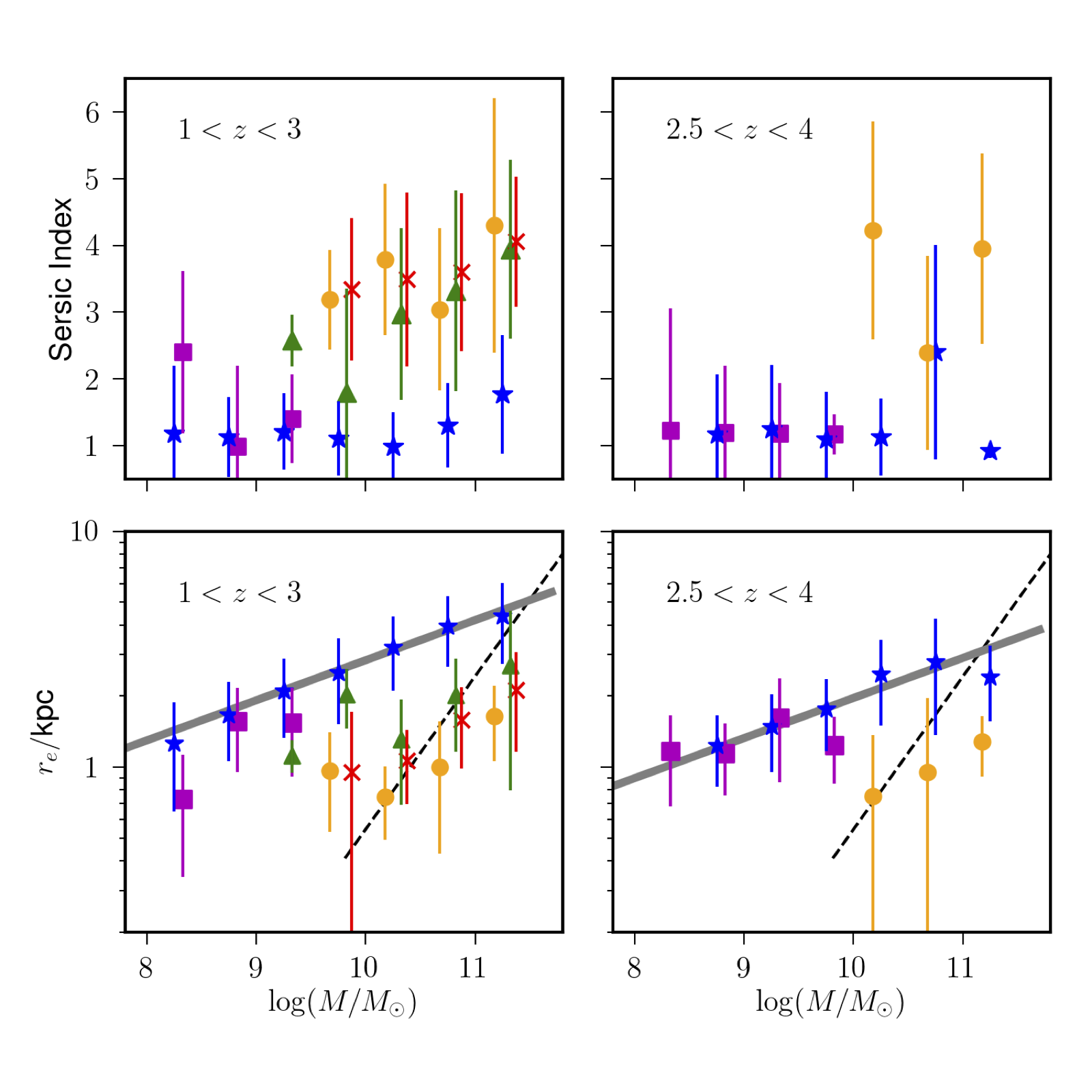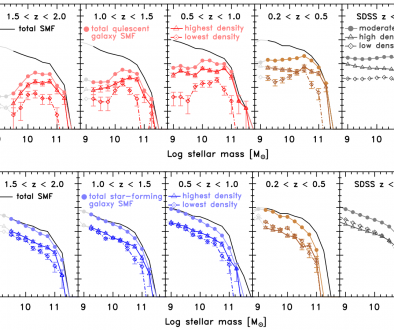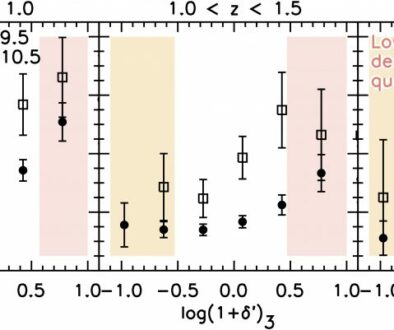Forrest 2018 Summary
We investigate the properties of galaxies as they shut off star formation over the 4 billion years surrounding peak cosmic star formation. To do this, we categorize ∼7000 galaxies from 1 < z < 4 into 90 groups based on the shape of their spectral energy distributions (SEDs) and build composite SEDs with R ∼ 50 resolution. These composite SEDs show a variety of spectral shapes and also show trends in parameters such as color, mass, star formation rate, and emission-line equivalent width. Using emission-line equivalent widths and strength of the 4000 Å break, D(4000), we categorize the composite SEDs into five classes: extreme emission line, star-forming, transitioning, post-starburst, and quiescent galaxies. The transitioning population of galaxies shows modest Hα emission (EWREST ∼ 40 Å) compared to more typical star-forming composite SEDs at log10(M/Msol) ∼ 10.5 (EWREST ∼ 80 Å). Together with their smaller sizes (3 kpc vs. 4 kpc) and higher Sérsic indices (2.7 vs. 1.5), this indicates that morphological changes initiate before the cessation of star formation. The transitional group shows a strong increase of over 1 dex in number density from z ∼ 3 to z ∼ 1, similar to the growth in the quiescent population, while post-starburst galaxies become rarer at z < 1.5. We calculate average quenching timescales of 1.6 Gyr at z ∼ 1.5 and 0.9 Gyr at z ∼ 2.5 and conclude that a fast-quenching mechanism producing post-starbursts dominated the quenching of galaxies at early times, while a slower process has become more common since z ~ 2.

Figure: Example composite SEDs for each of our classifications, plotted with vertical offsets for clarity. Emission line galaxies (ELGs; magenta), star-forming galaxies with (DSFG) and without (SFG) significant dust attenuation (blue), transition galaxies (TGs; green), post-starburst galaxies (PSBs; orange), and quiescent galaxies (QGs; red) are clearly distinguishable based on emission features and D(4000) strength. Figure: Morphological characteristics of galaxies in different composite SED classes. Top: Sérsic indices for galaxies in our sample according to mass and classification, color-coded as in previous figures. Points are slightly offset along the abscissa for clarity, and error bars show the 16%–84% range in values for analog galaxies in composite SEDs of the class and binned mass range. Bottom: size–mass plane for galaxies in our composite SEDs. The SF galaxies follow the size–mass relations from Allen et al. (2017) (thickgrayline) quite well, while at 1 < z < 3 all other classes are smaller in size for a given mass (left). At 2.5 < z < 4 (right), the ELGs have similar sizes, while PSBs are smaller. In both cases, the non-star-forming classes lie near the compactness selection criterion of Barro et al. (2013), shown as a dashed line.
Figure: Morphological characteristics of galaxies in different composite SED classes. Top: Sérsic indices for galaxies in our sample according to mass and classification, color-coded as in previous figures. Points are slightly offset along the abscissa for clarity, and error bars show the 16%–84% range in values for analog galaxies in composite SEDs of the class and binned mass range. Bottom: size–mass plane for galaxies in our composite SEDs. The SF galaxies follow the size–mass relations from Allen et al. (2017) (thickgrayline) quite well, while at 1 < z < 3 all other classes are smaller in size for a given mass (left). At 2.5 < z < 4 (right), the ELGs have similar sizes, while PSBs are smaller. In both cases, the non-star-forming classes lie near the compactness selection criterion of Barro et al. (2013), shown as a dashed line. Figure: Comoving number densities of QGs (red), PSBs (orange), TGs (green), and mass-matched SFGs (blue) against redshift. Our results are consistent with the results from Wild et al. (2016), shown as hatched shaded regions. Results from NMBS (Whitaker et al. 2012a) are shown as non-hatched shaded regions. Notably, the shapes of the TG and QG curves appear quite similar, which is suggestive of them being along a similar evolutionary pathway. While both these tracks flatten out toward lower redshifts, the PSBs show strong evidence for a turnover around z ∼ 1.5.
Figure: Comoving number densities of QGs (red), PSBs (orange), TGs (green), and mass-matched SFGs (blue) against redshift. Our results are consistent with the results from Wild et al. (2016), shown as hatched shaded regions. Results from NMBS (Whitaker et al. 2012a) are shown as non-hatched shaded regions. Notably, the shapes of the TG and QG curves appear quite similar, which is suggestive of them being along a similar evolutionary pathway. While both these tracks flatten out toward lower redshifts, the PSBs show strong evidence for a turnover around z ∼ 1.5.
We find evidence for galaxies with at least two quenching patterns. The greater and increasing number density of the TGs at low redshifts (0.5 dex larger than PSBs at z = 1.25) implies that this group/quenching pathway is becoming more common, while the PSBs are becoming rarer at z < 1.5. This is potentially due to a longer timescale associated with said pathway, on the order of 1.5 Gyr, a factor of 1.5–7 times longer than the post-starburst phase is expected to last, and which cannot have occurred before z ∼ 4. The process that brings SFGs into the green valley creates changes in galaxy color, sSFR, size, and Sérsic index. The morphologies of galaxies appear, on average, to begin evolution toward higher Sérsic index before star formation ceases.

